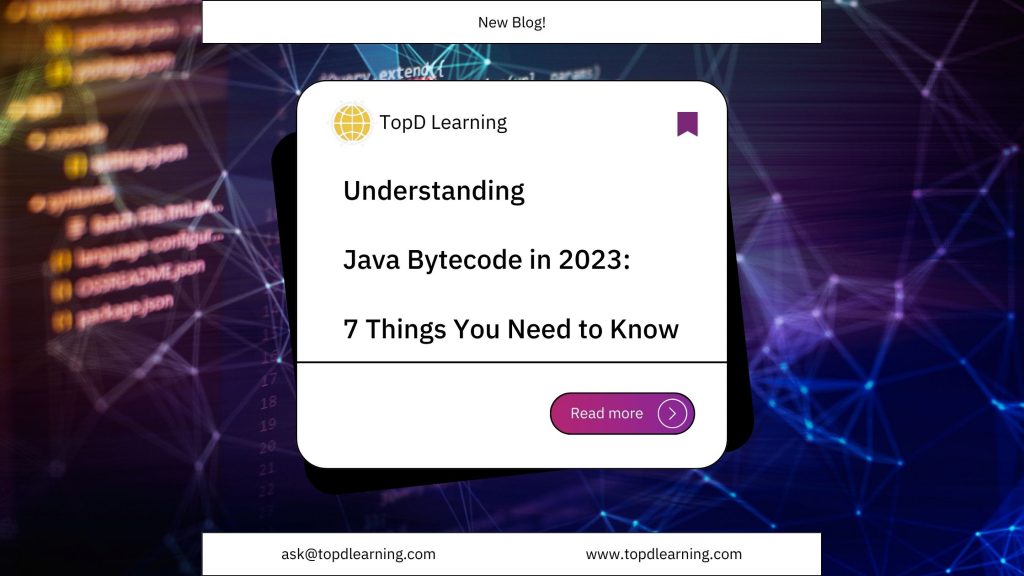Embark on a deep dive into Java Bytecode with our comprehensive guide. Understand its intricate structure, the significance of optimization, and gain expert insights for 2023. Enhance your Java skills with TopD Learning.
Table of Contents:
- What is Java Bytecode?
- The Structure of Java Bytecode
- The Importance of Java Bytecode Optimization
- 7 Things You Need to Know about Java Bytecode
Introduction
Welcome to the intricate world of Java Bytecode!
As we go through the technological landscape of 2023, a deep understanding of Java Bytecode has become indispensable for every Java developer. This blog post will provide you with an in-depth exploration of Java Bytecode, its complex structure, the art of optimization, and seven expert insights you need to know this year.
What is Java Bytecode?
Java Bytecode is the lifeblood of Java’s cross-platform compatibility. Here’s a more detailed look:
- Platform Independence: Java Bytecode is the intermediate representation of Java code, which is executed by the Java Virtual Machine (JVM). It is the bridge between human-readable Java source code and machine language that a computer’s processor understands.
- Compilation: It is the product of the compilation of Java source code by the Java Compiler (‘javac’). This process involves checking for errors in your code and translating it into a format that the JVM can understand and execute.
- Cross-Platform Compatibility: Java Bytecode is platform-independent, adhering to Java’s “write once, run anywhere” philosophy. This means that you can write your Java code on one machine, and the bytecode produced can run on any other machine that has a JVM, regardless of the underlying hardware and operating system.
The Structure of Java Bytecode
Understanding the structure of Java Bytecode is crucial for writing efficient code. Here are some deeper insights:
- Classes and Methods: Java Bytecode is organized into classes and methods, mirroring the structure of the original Java source code. Each class file contains a single class or interface definition.
- Instructions: Each method in the class file contains a sequence of instructions for the JVM. These instructions, known as opcodes, are low-level codes that manipulate data and control execution flow.
- Operand Stack and Local Variables: The instructions in Java Bytecode operate on an operand stack and a local variable array, providing a level of abstraction from the details of the underlying hardware.
The Importance of Java Bytecode Optimization
Optimizing Java Bytecode can significantly improve the performance of your Java applications. Here’s a deeper look at why it’s important:
- Performance Improvement: Bytecode optimization involves transforming the bytecode to make it run faster or use fewer resources. This can involve techniques like method inlining, where the call to a small method is replaced with the method’s code, eliminating the overhead of the method call.
- Resource Efficiency: Other optimization techniques include dead code removal, where unreachable code segments are eliminated, and constant propagation, where the values of known constants are substituted at compile time.
- Just-In-Time Compilation: Advanced JVMs also perform Just-In-Time (JIT) compilation, where frequently executed bytecode sequences are compiled to native machine code for faster execution.
7 Things You Need to Know about Java Bytecode
In 2023, these are the seven key insights about Java Bytecode you need to know:
- Platform Independence: Java Bytecode is the cornerstone of Java’s platform independence. It allows Java applications to run on any device with a JVM.
- Code Efficiency: Understanding the structure of Java Bytecode can help you write more efficient code. It provides insights into how your Java code is executed.
- Performance Improvement: Optimizing Java Bytecode can significantly improve the performance of your applications. Techniques like method inlining and constant propagation can make your code run faster.
- Security: Java Bytecode is secure. The JVM includes a bytecode verifier that checks the code for illegal operations, ensuring that it adheres to Java’s safety constraints.
- Manual Editing: Java Bytecode can be manually edited using tools like ASM or Javassist, providing opportunities for further optimization and manipulation.
- Disassembly: Tools like Javap can be used to disassemble compiled Java files into readable bytecode, providing insights into the compilation process.
- Advanced Concepts: Understanding Java Bytecode is essential for advanced Java concepts like Just-In-Time (JIT) compilation and garbage collection.
Conclusion
Mastering Java Bytecode is a critical step in becoming a proficient Java developer. It provides insights into the inner workings of Java, offers opportunities for optimization, and enhances your understanding of advanced Java concepts. As we continue to explore the ever-evolving landscape of Java in 2023, a solid grasp of Java Bytecode will undoubtedly be a valuable asset.
At TopD Learning, we are committed to helping you achieve this mastery. Our Java certification course, along with a variety of other IT and project management courses, are designed to equip you with the skills you need to excel in your career.
Join us at TopD Learning, and let’s decode the future of technology together.


